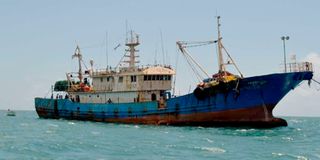Time Africa fished in its oceans

A crab fishing vessel christined MV Ahadi 001 at the Indian Ocean in Malindi, Kilifi County.
What you need to know:
- Africa’s chronic nutrient deficiency could be improved through the harvesting and consumption of abundant marine life.
- This is not happening, and Africa is losing its fish stock to illegal, unregulated and unreported fishing vessels from Europe, Asia and other far flung regions.
The preamble of the 2015 Agenda for Sustainable Development declares that it is a “supremely ambitious and transformational vision” for a world free of poverty, hunger, disease and want — tragedies that have come to define Africa and its people.
This universal, integrated and indivisible agenda promised, in SDG 14, to prioritise sustainable use of oceans, seas and marine resources to deliver economic benefits to developing countries.
In 2018, Nairobi hosted the Sustainable Blue Economy Conference to provide further engagement on SDG 14. The Conference offered African countries an opportunity to press developed nations and multilateral institutions on their commitments to help them meaningfully and sustainably explore marine resources.
Kenya, as the host nation, wowed attendees with its plans to create a “Blue Economy Bank” and “the African Blue Economy Innovation and Research Centre”. While admirable, these were likely nothing more than fashionable political rhetoric.
There are 38 countries and six islands on the African continent, sharing a resource-rich continental shelf that could, if exploited, generate as much as $1 trillion (Sh100 trillion) a year. Africa’s chronic nutrient deficiency, especially of proteins and some essential minerals, could be improved through the harvesting and consumption of abundant marine life, including fish.
This is not happening, and Africa is losing its fish stock to illegal, unregulated and unreported fishing vessels from Europe, Asia and other far flung regions.
Fish consumption
Furthermore, governments, continental institutions and multilateral partners have done little to empower locals to scale up fish production by means of modern equipment, including motorised boats.
The continent is home to about 20 percent of the global population yet accounts for just eight per cent of total fish consumption worldwide. The Food and Agricultural Organization (FAO) puts Africa’s per capita fish consumption of just 9.9 kilogrammes a year.
Regionally, West Africans consume the most fish per person (12kg) and East Africans the least (5kg). In contrast, fish per capita consumption among advanced countries is 24.4 kg.
In terms of fish farming, the continent contributes a paltry 2.7 per cent of the global output.
Indeed, Africa’s total aquaculture production is far less than what individual developing countries like China, India, Indonesia and Bangladesh produce.
Africa has negligible large motorised fishing vessels capable of conducting deep-sea fishing excursions. In 2017, Tunisia had 303 vessels that were longer than 24 metres followed by Senegal at 93, Sudan 60, Benin 21 and Mauritius two. In contrast, Myanmar, a relatively small South East Asian country with a population of 54 million, had 971 large fishing vessels.
Other countries with a significant fleet of large fishing boats include Taiwan (837), South Korea (1,336), Bangladesh (210), Mexico (240) and Chile (136).
Besides, FAO has attributed Africa’s low fish production to inadequate fishing, landing, storage and processing infrastructure. Also, lack of marketing and distribution channels is a hindrance to the emergence of commercialised fish activities.
Growing fish market
African governments have failed to invest in and deploy deep-sea fishing vessels like their peers. Yet every year, thousands of ships and boats, some in relatively good condition, are either discarded, beached or scrapped for metal.
Although low interest rates and cheap credit have served as an incentive for shipping lines to invest in newer and more efficient megaships and supertankers, fluctuations in trade volume have led to a situation of too many ships and too little cargo.
Shipping lines have responded by decommissioning and giving up their vessels for recycling. More than 700 large end-of-life ships are broken down by hand in hazardous conditions, a majority of them at three beach locations in India, Pakistan and Bangladesh.
There is a growing fish market in the region, as seen in the increasing fish imports from China. African governments should consider purchasing and repurposing affordably priced second-hand vessels for deep-sea fishing to boost production and consumption. This would be especially attractive to the littoral counties of Kilifi, Kwale, Lamu, Mombasa, Tana River and Taita-Taveta, which have the highest rural poverty headcount of 48 per cent.
These counties also suffer from severe youth unemployment, low education outcomes and an underdeveloped agricultural sector. Commercial fishing could generate thousands of decent jobs for the youth, boost protein intake and give the region a real economic lift and diversification.
Africa’s shores are dotted with many large infrastructure projects of little use — like the Lamu port and the failed Galana Kulalu irrigation scheme. The blue economy bank and a research centre can wait. It’s time we harvested our oceanic riches that foreigners are plundering at will. These are low-hanging fruits.
Mr Chesoli is a New York-based development economist and global policy expert. [email protected]





